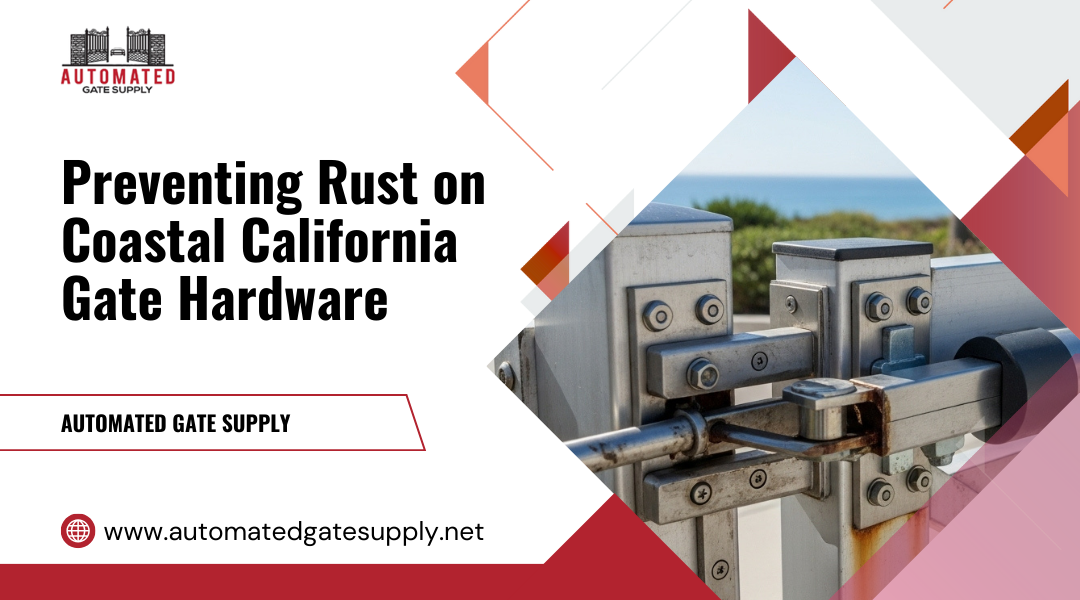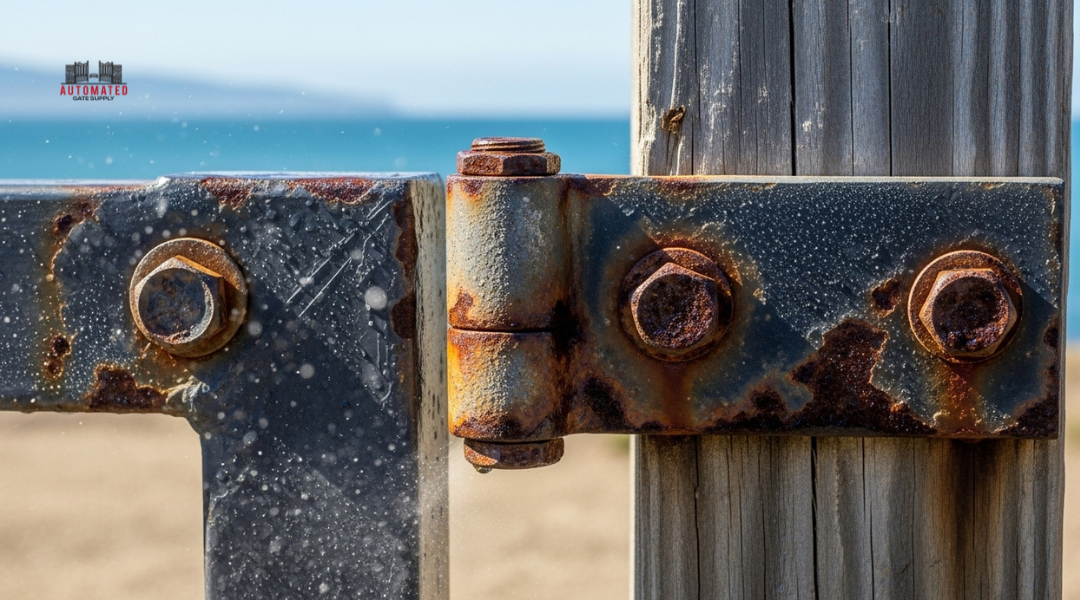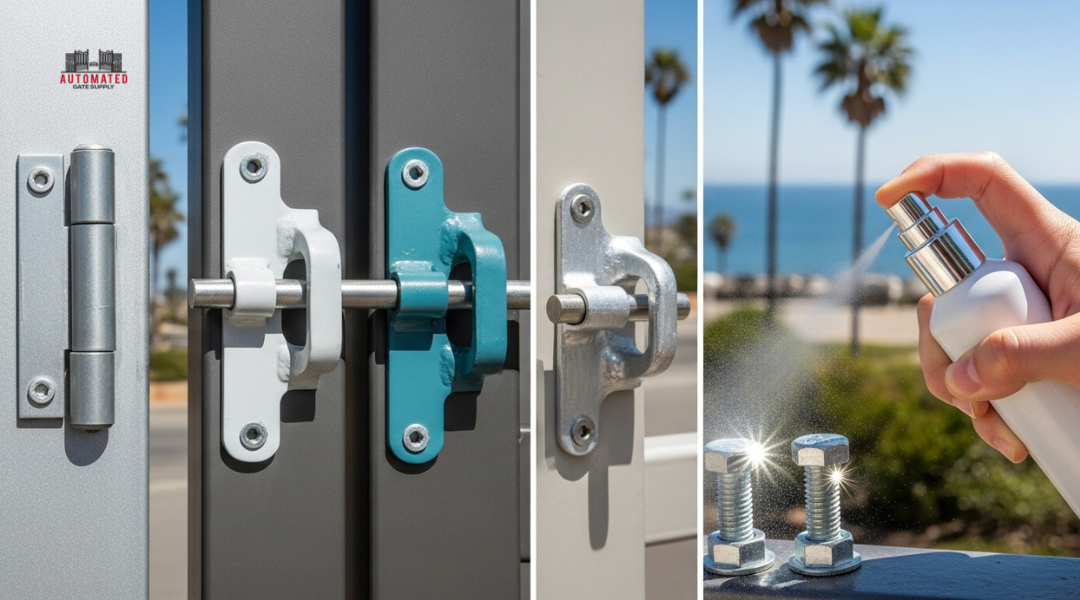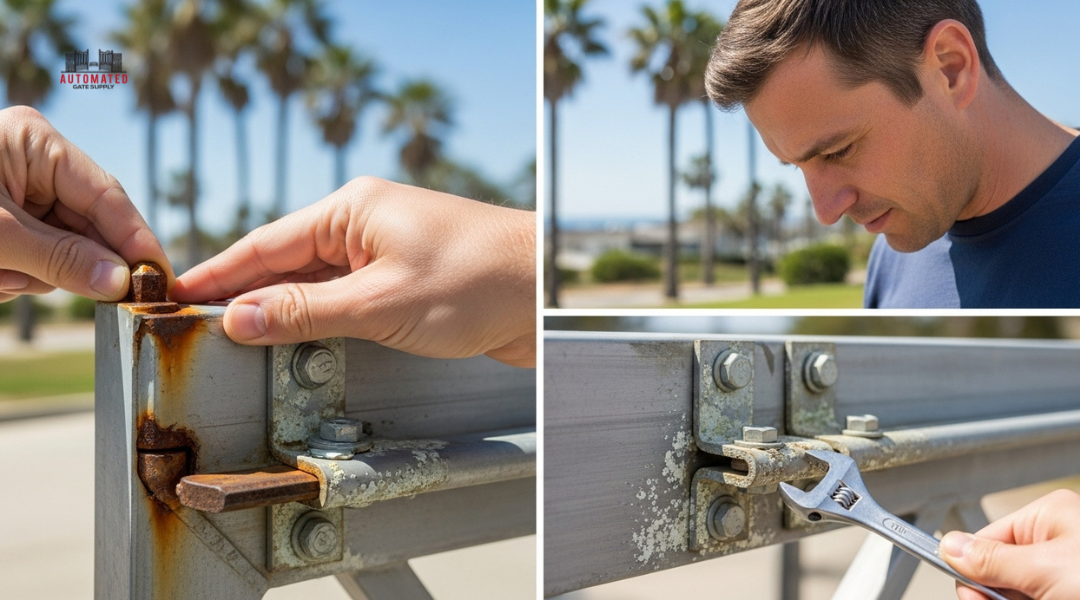Living in coastal California offers stunning ocean views and perfect weather, but the constant salt air creates a serious challenge for metal gate hardware. Your gate’s hinges, rollers, and fasteners face relentless exposure to corrosive salt particles that can cause rust and premature failure within just a few years.
The good news is that preventing rust on coastal gate hardware doesn’t require expensive tools or advanced technical skills—just the right materials, protective coatings, and simple maintenance routines. Many homeowners assume they need to replace their entire gate system when hardware fails, but smart prevention strategies can extend your gate’s lifespan by decades while maintaining smooth, reliable operation.
This guide walks you through five straightforward steps to protect your gate hardware from coastal wear and tear, plus common mistakes to avoid and when professional help makes sense. You’ll learn how to choose rust-resistant materials, apply protective barriers, establish effective cleaning routines, and spot problems before they become costly repairs.
Step 1: Understand Why Coastal Gates Rust Faster
Coastal California’s salty air carries microscopic particles that accelerate rust formation on metal gates. Combined with ocean moisture, these conditions create the perfect storm for corrosion that happens much faster than inland areas.
Salt in the Air: The Invisible Enemy
Salt particles from ocean spray travel miles inland, coating your gate hardware with a thin layer of sodium chloride. You can’t see this coating, but it acts like a magnet for moisture from the air.
When salt accumulates on metal surfaces, it creates an electrochemical reaction that speeds up oxidation. This process happens even when your gate isn’t directly exposed to ocean spray. Salt particles can travel up to 10 miles inland in coastal California.
The chloride ions in salt are particularly aggressive toward iron and steel. They break down protective oxide layers that naturally form on metal surfaces. Once this protection is compromised, rust formation accelerates rapidly.
Even stainless steel, which normally resists corrosion, can develop pitting and crevice corrosion in high-salt environments. Your gate hardware faces constant exposure to these corrosive elements every single day.
Why Moisture + Metal = Corrosion Trouble
Coastal areas maintain higher humidity levels year-round compared to inland regions. This persistent moisture provides the water component necessary for rust formation on iron and steel components.
Morning fog and ocean mist create ideal conditions for corrosion. When moisture combines with salt deposits on your gate hardware, it forms a corrosive solution that attacks metal surfaces continuously.
The rust formation process requires three elements:
- Iron or steel
- Oxygen from air
- Water or moisture
Coastal California provides abundant moisture through fog, high humidity, and ocean proximity. This constant dampness prevents your gate hardware from fully drying between weather events.
Temperature fluctuations between day and night also contribute to condensation formation. This cycle of wetting and partial drying accelerates the corrosion process on exposed metal surfaces.
Step 2: Pick Materials That Can Handle the Coast
The right materials can make the difference between a gate that lasts decades and one that fails within years. Stainless steel, aluminum, and galvanized options each offer distinct advantages, while cheap fasteners often become the weakest link in coastal installations.
Stainless, Aluminum, and Galvanized — What Works Best
Stainless steel stands as the premium choice for coastal gate hardware. Type 316 stainless steel contains molybdenum, which provides superior resistance to chloride corrosion. This grade handles direct salt spray without pitting or rust formation.
Type 304 stainless steel costs less but offers adequate protection for most coastal applications. It works well when not directly exposed to salt spray.
Aluminum gates provide excellent corrosion resistance through natural oxidation. The material forms a protective layer that prevents further deterioration. Marine-grade aluminum alloys like 5052 and 6061 perform best in coastal environments.
Aluminum requires minimal maintenance and weighs significantly less than steel alternatives. This reduces stress on hinges and mounting hardware.
Galvanized steel gates offer strong protection through zinc coating. Hot-dip galvanizing provides thicker, more durable coverage than electroplated options. The zinc sacrifices itself to protect the underlying steel from corrosion.
| Material | Salt Resistance | Cost | Maintenance |
|---|---|---|---|
| 316 Stainless | Excellent | High | Very Low |
| 304 Stainless | Good | Medium | Low |
| Aluminum | Excellent | Medium | Very Low |
| Galvanized Steel | Good | Low | Medium |
The Hidden Problem with Cheap Fasteners
Your gate’s strength depends entirely on its weakest component. Cheap fasteners made from plain steel or low-grade materials will corrode first, causing complete hardware failure.
Standard zinc-plated screws and bolts deteriorate rapidly in salt air. The thin plating wears off within months, exposing bare steel underneath.
Use marine-grade fasteners exclusively. Choose 316 stainless steel bolts, screws, and washers for critical connections. These cost more upfront but prevent catastrophic failures.
Dissimilar metals create galvanic corrosion when they contact each other. Avoid mixing aluminum hardware with steel fasteners. Use stainless steel fasteners with all gate materials to prevent electrochemical reactions.
Replace all factory hardware if your gate came with standard fasteners. Manufacturers often use cheap components to reduce costs, even on expensive gates designed for coastal use.
Step 3: Protect with Coatings and Barriers
Protective coatings act as shields between your gate hardware and coastal elements. Quality sprays and lubricants provide ongoing protection that maintenance alone cannot achieve.
Powder Coating, Galvanizing, and Paint (Explained Simply)
Powder coating creates the strongest barrier for gate hardware. This process applies electrostatically charged powder particles that bake into a thick, uniform layer. The coating bonds directly to metal surfaces and resists chips, scratches, and moisture penetration.
Galvanizing dips metal parts in molten zinc. The zinc layer corrodes before your hardware does, sacrificing itself to protect the underlying metal. This cathodic protection works even when the coating gets scratched.
Marine-grade paints contain zinc-rich primers that provide similar sacrificial protection. Apply primer first, then two coats of marine paint designed for saltwater exposure.
Best Options by Hardware Type:
- Hinges: Powder coating or galvanizing
- Latches: Marine paint with zinc primer
- Bolts/screws: Galvanized hardware only
Powder coating costs more upfront but lasts 10-15 years without maintenance. Galvanizing provides excellent value for frequently replaced hardware. Paint requires reapplication every 3-5 years but offers the most color options.
Sprays and Lubricants That Actually Help
Marine-grade penetrating oils displace moisture and leave protective films. Apply these products monthly during winter months when salt exposure peaks. Products containing lanolin or synthetic polymers perform better than basic petroleum lubricants.
Corrosion inhibitor sprays create invisible barriers that repel salt and moisture. These aerosol products reach into crevices where brushes cannot apply paint or coatings.
Application Schedule:
- Heavy exposure areas: Bi-weekly treatment
- Protected locations: Monthly application
- After storms: Within 48 hours
Silicone sprays work well for moving parts like hinges and slide bolts. Avoid petroleum-based products that attract dirt and break down quickly in UV light.
White lithium grease provides long-lasting lubrication for pivot points. This thick consistency stays in place despite rain and wind exposure.
Step 4: Keep a Simple Cleaning and Lubrication Routine
Consistent maintenance prevents salt buildup from destroying your gate hardware and keeps moving parts operating smoothly. A monthly rinse removes corrosive deposits while proper lubrication protects against moisture and reduces friction wear.
Rinse Off Salt Like Washing Your Car
Salt accumulation on gate hardware works exactly like salt buildup on your car after beach trips. The crystals attract moisture and accelerate corrosion on metal surfaces.
Monthly rinse schedule works best for most coastal locations. Use a garden hose with moderate pressure to wash away salt deposits from all hardware surfaces.
Focus on these critical areas:
- Hinge pins and pivot points
- Roller tracks and wheels
- Chain links and sprockets
- Lock mechanisms and latches
Start at the top of your gate and work downward. This prevents dirty water from dripping onto already-cleaned components.
Avoid pressure washers on delicate mechanisms. High pressure forces water into sealed bearings and can damage protective coatings.
After rinsing, wipe down hardware with a clean cloth. Pay special attention to crevices where salt water collects and dries.
Lubricating Hinges, Rollers, and Chains Without Making a Mess
Apply lubricant immediately after cleaning while surfaces are still damp. This displaces remaining moisture and creates a protective barrier.
Marine-grade white lithium grease works best for hinges and pivot points. It resists washout and provides long-lasting protection against salt air.
Chain and cable lubricants should be specifically designed for outdoor use. Avoid household oils that attract dirt and become sticky.
Application technique matters:
- Wipe excess grease from visible surfaces to prevent dirt accumulation
- Work moving parts several times to distribute lubricant evenly
- Apply thin coats rather than heavy buildup
Use a small brush or cloth to apply lubricant precisely. This prevents overspray on painted surfaces or decorative elements.
Frequency depends on exposure level. Gates within 500 feet of the ocean need lubrication every 4-6 weeks. Gates further inland can go 8-12 weeks between applications.
Step 5: Check Hardware Regularly Before It Fails
Coastal salt air attacks your gate hardware constantly, making regular inspections your best defense against sudden failures. Knowing exactly where rust typically appears first and recognizing early warning signs can save you from expensive emergency repairs.
Hinges, Tracks, and Brackets: Where Rust Strikes First
Your gate’s hinges bear the most stress and collect the most moisture, making them rust magnets in coastal environments. Check hinge pins monthly for any orange or brown discoloration, especially where the pin meets the hinge barrel.
Look for rust buildup in the pivot points where metal contacts metal. These areas trap salt water and create perfect conditions for corrosion.
Track systems on sliding gates need special attention. Salt accumulates in the bottom track channels where water pools after rain or fog. Run your finger along the track to feel for rough spots or pitting.
Gate mounting brackets connect your hardware to posts and frames. Inspect where brackets attach to wood or concrete, as these joints often trap moisture. Proper installation with adequate drainage prevents water from sitting in these critical connection points.
Check all bolts and screws monthly using a simple wrench test. If fasteners turn easily when they shouldn’t, corrosion may have weakened the threads.
Easy Signs of Trouble You Can Spot in Seconds
You don’t need special tools to catch hardware problems early. Visual inspection reveals most issues before they become serious failures.
Watch for white or green powder around metal joints – this indicates active corrosion eating away at your hardware. Dark stains running down from hinges or brackets show where rust is bleeding through protective coatings.
Listen to your gate during operation. New squeaking, grinding, or clicking sounds mean moving parts need immediate attention. Gate maintenance includes noting these audio clues before they signal complete failure.
Test gate movement weekly by opening and closing it completely. Any hesitation, binding, or uneven motion indicates alignment problems or hardware wear that coastal conditions accelerate.
Look for loose hardware by checking if mounting brackets move when you push on them. Properly installed hardware stays rock-solid under normal pressure.
Common Mistakes Homeowners Make
Many coastal California homeowners wait too long to address minor rust issues and choose inappropriate maintenance products. These two oversights can turn small problems into expensive gate replacements within just a few years.
Ignoring Little Rust Spots Until They Spread
You might notice small brown spots on your gate hinges or latches and think they’re not worth immediate attention. This approach costs coastal homeowners hundreds of dollars in unnecessary repairs every year.
Rust spreads exponentially once it starts. A single quarter-sized rust spot can expand to cover an entire hinge within six months in coastal conditions.
Early rust removal takes minutes:
- Sand the spot with 220-grit sandpaper
- Apply rust converter or primer immediately
- Touch up with matching paint
Once rust penetrates deep into the metal, you’ll need to replace entire hardware pieces. A $3 touch-up job becomes a $150 hinge replacement.
Check your gate hardware monthly for new rust spots. Focus on bolt heads, hinge pins, and latch mechanisms where water tends to collect. Salt air accelerates rust formation, making weekly inspections worthwhile during winter months when ocean storms are frequent.
Using the Wrong Lubricants That Attract Dirt
Many homeowners grab whatever spray lubricant they have in the garage without considering coastal conditions. Standard penetrating oils attract sand and salt, creating an abrasive paste that wears down moving parts.
Avoid these common lubricant mistakes:
- WD-40 for long-term lubrication
- Heavy grease that traps sand particles
- Petroleum-based products that break down in salt air
Marine-grade lithium grease works best for coastal gate hardware. It repels water and doesn’t attract dirt like lighter oils. Apply it to hinge pins, latch springs, and lock mechanisms every three months.
White lithium grease stays cleaner longer than standard lubricants. You’ll spend less time cleaning gunked-up hardware and your gates will operate smoothly between maintenance sessions.
When to Call a Pro Instead of DIY
Gate hardware problems in coastal California range from simple surface rust you can tackle yourself to complex corrosion that requires professional expertise. Knowing which repairs need professional attention can save you money and prevent further damage to your gate system.
Minor Fixes You Can Handle Yourself
Surface rust removal is the most common DIY task for coastal gate hardware. You can handle this when rust appears as light orange or brown spots on hinges, latches, or screws without affecting the metal’s structural integrity.
Clean surface rust with a wire brush or sandpaper. Apply naval jelly rust remover for stubborn spots. Rinse thoroughly and dry completely before applying primer and paint.
Basic lubrication of moving parts requires no special skills. Spray hinges, locks, and pivot points with marine-grade lubricant monthly. This prevents salt buildup and keeps mechanisms working smoothly.
You can also replace individual screws and small hardware pieces when they show minor corrosion. Remove corroded fasteners with penetrating oil and replace with stainless steel alternatives.
Cleaning salt deposits from hardware surfaces needs only soap, water, and a soft brush. Do this weekly in high-salt areas to prevent buildup that leads to deeper corrosion.
Serious Corrosion That Needs Expert Help
Structural damage from rust requires professional assessment when metal components show pitting, flaking, or actual holes. Corroded hinges that no longer align properly need expert repair or replacement to maintain gate security.
Professional help becomes essential when electrical components like automatic gate openers show corrosion damage. Salt exposure can damage circuit boards, sensors, and wiring in ways that create safety hazards.
Complete hardware replacement often needs professional installation. Gate posts, heavy-duty hinges, and locking mechanisms require proper alignment and mounting techniques to function correctly in coastal conditions.
Call professionals when you encounter galvanic corrosion between different metals. This appears as severe deterioration where dissimilar metals contact each other. Proper repair requires understanding of metal compatibility and specialized installation techniques.
Warranty considerations also matter for expensive gate systems. Professional installation maintains coverage while DIY repairs may void manufacturer protections on automatic openers and high-end hardware.





